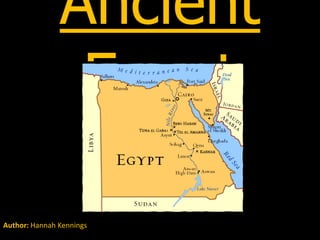
Blog 5
- 1. Ancient Egypt Author: Hannah Kennings
- 2. The ancient Egyptian society was basically ruled by religion. They believed there were Gods that controlled everything. Although their beliefs were constantly changing there were a few that remained the same, these included; fertility, rebirth, death and resurrection. http://www.ancient-egypt.info/2012/02/introduction-about-ancient-egyptian.html
- 3. Anubis Anubis also known as the God of death is associated with the jackal, an animal that is representative of tombs of death. Anubis can be seen as half human half jackal or as full jackal. The role of Anubis is to oversee the embalming and mummification process as well as to guide the dead to their fate through the weighing of the heart process. http://www.spiritweb.us/egypt/egyptian-gods.html
- 4. The mummification process was a very crucial step for the Egyptians to make it to the afterlife. After a person died their bodies were embalmed and mummified to preserve them for the afterlife. http://egy-king.blogspot.com.au/2012/09/ancient-egyptian- mummies.html
- 5. Mummification was generally only performed on the rich pharaohs as it was too expensive for the poor. It was quite a long process usually taking 70 days there were many steps involved in mummification they include; removal of all organs with the exception of the heart, drying the body with salt, covering the body with oils and wrapping the body in bandages.
- 6. Osiris Osiris is the god of the underworld, he is depicted in human form wrapped as a mummy. Osiris also overseas the weighing of the heart ceremony. The Egyptians that had a good heart were taken by Osiris to the paradise (afterlife). http://www.ancient-egypt-online.com/osiris.html
- 7. Ammit The Egyptians hearts that were heavier than the feather did not proceed to the after life with Osiris, their hearts were eaten by Ammit also known as “the devourer”. http://egyptology007.blogspot.com.au/2009/12/ammit-also-spelt- ammut-and-ahemait.html
- 8. The strong belief that Egyptians had in life after death is what prompted the building of the famous pyramids of Egypt. Egyptians believed that in order to get to the afterlife your body needed to be preserved (mummified), and everything that you would need would be put into your tomb. http://travel.smart-guide.net/the-pyramids-of-egypt
- 9. In the early days pharaohs built small tombs called mastabas that had enough room for the coffin and some things to take with you to the afterlife. As time went on the pharaohs wanted to make their tombs greater so they began to built their mastabas bigger and bigger and this is how the great pyramids of Egypt were created.
- 10. After the mummification process the pharaohs were taken to their tomb. The journey from the embalmers tents to the tomb was a procession where mourners would follow and people would dance. When they reached the Nile river the tomb would be ferried across, family members in the first boat followed by the mummy and priests. The family members of the mummy would carry canopic jars and other items for the after life all the way to the ‘Wabet’. http://australianmuseum.net.au/Funerals-in-ancient-Egypt/
- 11. The “Wabet” is at the front of the tomb where the rest of the ceremony is performed. The opening of the mouth ceremony is one of the last steps before the mummy is laid to rest in the tomb. The Egyptians believed that this ceremony would allow the deceased to hear, see, smell and breathe in the afterlife. http://ib205.tripod.com/burial.html,
- 12. One of the most famous tombs to be found recently is the tomb of the young pharaoh Tutankhamun. Tutankhamun became pharaoh at around age 9 and died at 19, his tomb was found in the valley of the kings in 1922 by Howard Carter. King Tut’s funeral was believed to be completed very hastily as he died suddenly http://www.australiangeographic.com.au/journal/view-image.htm?gid=8691
- 13. The thing that made Tutankhamun so famous was the discovery of his tomb. The tomb that was discovered by Howard Carter in 1922 was one of the most intact tombs ever found. Tutankhamun's tomb had survived around 3000 years of floods and had only been robbed twice, it was filled with treasures for the afterlife including a number of chariots. http://archaeologyexcavations.blogspot.com.au/2012/05/howard-carter-138th-birthday.html http://www.australiangeographic.com.au/journal/view-image.htm?gid=8691
- 14. Although this process of death is a major part of Egypt's history it is not common practice in modern Egypt. Mummification no longer occurs and Egypt is filled with people from many different religions. There are still some rich Egyptians that are buried in tombs, but these modern day tombs are designed for the families to visit the dead and mourn their loss rather than keeping the dead safe for the afterlife. http://archaeologynewsnetwork.blogspot.com.au/2011/01/modern-egypt-tombs-for- living.html#.UGDteY1lSPk